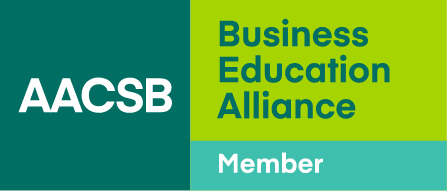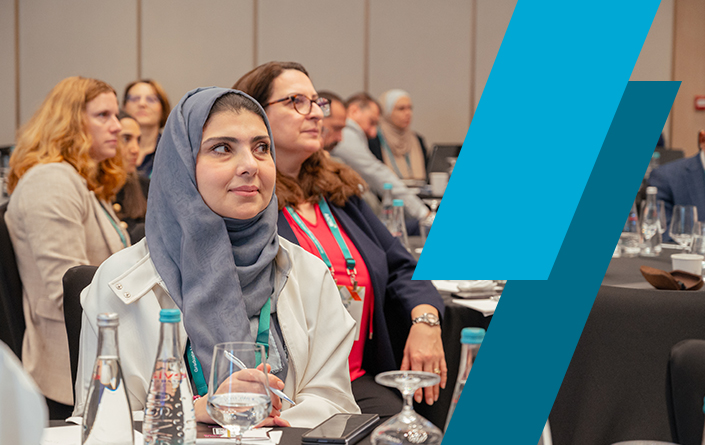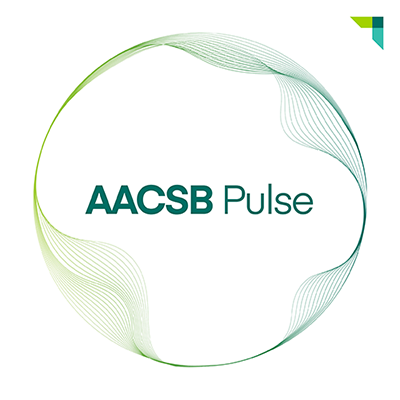2025 State of Accreditation Report
Welcome to the 2025 State of Accreditation Report. AACSB is proud to once again present insights from accreditation visits completed during the past academic year. Designed to foster collective learning among our members, this report reflects our commitment to continuous improvement and showcases important outcomes, exemplary practices, and areas for future growth.
Business Accreditation
Business Accreditation as of June 30, 2025

2024–25 Accreditation Outcomes
AAC, IAC, and CIRC Committee Meeting Outcomes, July 1, 2024, through June 30, 2025
Notes:
Data displayed are for initial and extended accreditations as of June 30, 2025.
Total number of schools extending accreditation: 232 (includes business and accounting).
Total number of schools achieving initial business accreditation: 27.
Total number of schools achieving initial accounting accreditation: 3.
Initial Business Accreditation
Number of Schools in Process as of June 30, 2025
| Total: 283 |
Initial Accreditation Visits Between July 1, 2024, and June 30, 2025, Outcomes by Region
| Total: 28 |
Continuous Improvement Review
Continuous Improvement Review Visits Between July 1, 2024, and June 30, 2025, Outcomes by Region
| Total: 215 |
2024–25 Accreditation Insights
Business Standards Most Cited by Peer Review Teams
Schools With Visits Between July 1, 2024, and June 30, 2025, With Accredit and Extend Recommendations
In peer review team reports for both initial accreditation and continuous improvement review (CIR) visits in 2024–25, the following standards are cited the most frequently as having issues that schools need to address by their next visit.

Source: School Decision Reports
Standard 3: Faculty and Professional Staff Resources—Common Issues |
- Alignment With Mission: Peer review teams underscored the need to align faculty deployment, teaching assignments, and scholarly output with the school’s mission and strategic objectives. Their reports highlighted the importance of ensuring that faculty activities are mission-driven and that resources are allocated in ways that reinforce the school’s distinctive identity and goals.
- Faculty Qualifications and Sufficiency: Peer review teams stressed the need for schools to consistently evaluate and monitor faculty credentials to ensure alignment with AACSB standards and evolving academic expectations.
- Balance of Teaching and Research: Reviewers also highlighted the challenge of balancing teaching responsibilities with research contributions. Schools are advised to carefully manage faculty workloads to ensure that teaching quality remains high while also fostering a robust culture of scholarly productivity.
For more information on insights related to Standard 3, please see Faculty Insights.
Standard 1: Strategic Planning—Common Issues |
- Innovation and Adaptability: Peer review teams advised schools to remain responsive to industry changes, new technologies, and evolving market demands by adopting creative approaches in curriculum design, teaching practices, and program development. Teams highlighted adaptability as an essential part of maintaining relevance and competitiveness.
- Data-Driven Planning and Metrics: Teams underscored the need for schools to use measurable objectives, performance indicators, and analytics to guide strategic planning. Their reports emphasized that data-driven approaches enable schools to track progress, assess outcomes, and make informed decisions that strengthen accountability and continuous improvement.
- Faculty and Staff Involvement: Peer reviewers also highlighted the value of involving faculty and staff actively in the strategic planning process. They observed that broad participation fosters collaboration, builds ownership of initiatives, and enhances the likelihood of effective implementation. Schools were encouraged to cultivate a culture of shared responsibility for advancing strategic priorities.
For more information on insights related to Standard 1, please see Strategic Planning and Risk Analyses Insights below.
Standard 5: Assurance of Learning—Common Issues |
- Assessment Design and Rigor: Peer review teams emphasized the importance of developing and refining robust assessment systems that include both direct and indirect measures of student learning. They pointed to the need for greater rigor in the design of these systems to ensure that they provide reliable evidence of learning outcomes and support continuous quality enhancement.
- Alignment With Goals and Outcomes: Peer reviewers encouraged schools to clearly define and consistently measure competency goals and outcomes across all programs. The reports underlined the importance of aligning program objectives with assessment processes to demonstrate that graduates achieve the competencies set forth by the school.
- Data Management and Reporting: Peer review teams emphasized the role of effective data systems in tracking, analyzing, and reporting assessment results. Schools were encouraged to strengthen their use of data to support evidence-based decision-making, identify areas for improvement, and enhance transparency in demonstrating learning outcomes.
Standard 3 was cited for 83 percent of schools with a CIR2 recommendation.
Strategic Planning and Risk Analyses Insights
Core Goals/Strategic Priorities within School Strategic Plans
These were the most commonly cited strategic priorities within the strategic plans of schools with accreditation visits in 2024-2025:
- Financial Sustainability and Resource Development: As part of their strategy, many schools stress the importance of resource management and growth by increasing fundraising and donor support, capturing external grants, diversifying revenue streams (including executive and online education), and aligning enrollment growth with institutional strategies.
- Student Success and Learning Outcomes: Business schools aim to improve the student experience by updating curricula with relevant and emerging content (such as fintech, data science, and interdisciplinary majors), strengthening advising and retention systems, and expanding experiential learning opportunities like internships, consulting projects, and partnerships with local businesses.
- Academic Excellence and Innovation: Schools are focused on maintaining program quality and competitiveness through continuous curriculum improvement, integrating innovative pedagogies and instructional technologies, and expanding graduate offerings that align with industry and societal needs.
- Community Engagement and Societal Impact: A recurring theme in school strategic plans is the emphasis on building meaningful connections with local, regional, and global communities. Schools aim to advance social mobility, support economic development, and promote the public good through outreach initiatives, partnerships, alumni networks, and employer engagement.
- Faculty Development and Research Productivity: Faculty remain a central priority, with schools aiming to recruit, retain, and develop high-quality faculty, provide professional development and training, and incentivize impactful scholarship that enhances reputation and contributes to societal advancement.
18.45
average number of pages in strategic plans
4.9
average number of years strategic plans cover
5.2
average number of goals in strategic plans
10
average number of risks reported in school risk analyses
Top 5 Categories Identified in School Risk Analyses
Risk Categories
|
Source: School Strategic Plans and Risk Analyses
Faculty Insights
Faculty Qualification Ratios for Schools With Visits in 2024–25

Note: The category of Additional Faculty, representing 4 percent, is not included above.
The overall participating faculty ratio for schools visited in 2024–25 is 87 percent.
Scholarly Academic Ratios by Discipline
Most Frequently Reported Disciplines
Intellectual Contribution Insights
Intellectual Contribution Outputs for Schools With Visits in 2024–25
Portfolio of Intellectual Contributions (n=215,724)
Note: Values have been rounded and may not equal 100 percent.
Types of Intellectual Contributions (n=213,465)
Disciplines Producing the Most Intellectual Contributions
Top Scholarly Impact Themes
| Theme | Description | Number of Schools | |||||
|---|---|---|---|---|---|---|---|
| Societal Impact | Research addressing broad societal challenges such as sustainability, ethics, economic development, and public health, often with measurable benefits to communities and stakeholders. | 153 | |||||
| Influence on Professional Practice | Scholarship shaping business and management practices, informing industry standards, and being implemented directly in organizational processes or professional fields. | 142 | |||||
| Community and Industry Engagement | Collaborations with local communities, nonprofits, and corporate partners that lead to applied projects, training programs, or tangible social/economic outcomes. | 139 | |||||
| Student and Curriculum Integration | Research embedded into teaching through cases, co-authored student publications, experiential learning projects, and curriculum design enhancements. | 138 | |||||
| Citations and Scholarly Influence | Evidence of academic reach through citation counts, presence in high-ranked journals, and recognition within the scholarly community. | 132 | |||||
Supplemental Accounting Accreditation
Accounting Visit Outcomes Between July 1, 2024, and June 30, 2025
| Total: 40 |
Accounting Standards Most Cited by Peer Review Teams for Visits Between July 1, 2024, and June 30, 2025, With Extend Recommendations
In peer review team reports for accounting continuous improvement review (CIR) visits in 2024–25, the following standards are cited the most frequently as having issues that schools need to address by their next visit:

Source: Accounting Unit Decision Reports
Standard A1: Accounting Academic Unit Mission, Impact, and Innovation |
- Impact Definition and Evidence: Peer review teams noted the value of articulating specific intended impacts and providing evidence of progress through well-defined outcomes, metrics, and performance indicators. They emphasized that impact should be visible both internally and externally to demonstrate effectiveness.
- Innovation in the Accounting Unit: Teams encouraged schools to embed innovation in curricula, pedagogy, and engagement activities to advance the unit’s mission and strengthen distinctiveness. They further stressed that innovation should be systemic and sustainable, not just tied to isolated initiatives.
Standard A4: Accounting Curriculum Content and Assurance of Learning |
- Student-Centered Learning and Outcomes: Peer review teams highlighted the importance of designing programs that prioritize student engagement, success, and measurable learning outcomes. They suggested approaches that foster active learning and deeper connections between students and faculty.
- Curriculum Relevance and Innovation: Teams underscored the need for curricula to remain current, innovative, and responsive to industry demands. To achieve this, accounting units should focus on integrating emerging trends and creative approaches to maintain competitiveness.
- Assurance of Learning (AoL) and Continuous Improvement: Reviewers urged accounting units to use data to drive decisions in the AoL process. They highlighted the need to document how results lead to meaningful improvements in programs and student outcomes.
Standard A6: Accounting Faculty Sufficiency, Credentials, Qualifications, and Deployment |
- Faculty Development and Support: Team reports highlighted the need for accounting units to provide ongoing opportunities for faculty development, research, and professional engagement. The peer reviewers emphasized that sustained investment in faculty strengthens teaching quality, research impact, and industry relevance.
- Balance of Professional and Scholarly Faculty: Peer review teams stressed the value of maintaining a balanced mix of faculty with academic and professional backgrounds. They noted that such diversity is essential to meeting varied program needs and enhancing the learning experiences of accounting students.
Volunteers

Featured Volunteers:
Rama Yelkur, Texas Woman's University;
Kangjuan Lyu, Shanghai University;
Scott Dawson, University of Colorado Denver;
Didi Achjari, Universitas Gadjah Mada;
Cristina Velez-Valencia, Universidad EAFIT;
Mayada Youseff, United Arab Emirates University; and
Keith Willoughby, University of Saskatchewan
Volunteer Representation in 2024–25
Notes:
This list includes individuals who served as a volunteer between July 1, 2024, and June 30, 2025, in one of the following roles:
• Operating Committee Member (Accounting Accreditation Committee—AAC; Accounting Accreditation Policy Committee—AAPC; Business Accreditation Policy Committee—BAPC; Continuous Improvement Review Committee—CIRC; Initial Accreditation Committee—IAC)
• Mentor (business or accounting)
• Team Chair (business or accounting)
• Team Member (business or accounting)
Only individuals who agreed to be listed are included. If your name does not appear and you served on one of the roles listed above between July 1, 2024, and June 30, 2025, and would like to be added, please contact us at [email protected]. Thank you.
Satisfaction With Accreditation Experience
| 96% | School Satisfaction With 2020 Standards Visit |
| 98% | School Satisfaction With myAccreditation |
| 98% | Volunteer Training Preparation for Accreditation Visit |
| 92% | Satisfaction With Volunteer Training |
| 1030 | Volunteers Have Been Trained Overall on the 2020 standards |
| 144 | Volunteers Were Trained in 2024–25 |
| 353 | Volunteers Completed the Refresher Training |
Innovation: Focus on GenAI
Generative AI is rapidly reshaping industries, creating both opportunities and challenges for businesses. This section explores best practices in leveraging AI while underscoring the vital role that AACSB and business schools play in tracking emerging trends and preparing future leaders to navigate an AI-driven world.
AI Exemplars
- Abu Dhabi University launched two professional development certificates aimed at integrating AI into teaching and learning through its SMART Learning Center. One certificate, AI-Enhanced Teaching and Learning, trains faculty in applying AI tools, using AI-driven analytics to assess outcomes, and designing AI-integrated curricula to boost engagement and analytical skills. The second certificate, Art and Science of Teaching, focuses on foundational pedagogy, including technology integration, ethical practices, and strategies for inclusive, student-centered instruction. Together, the programs reflect the university’s efforts to equip educators with both theoretical and practical AI expertise for the modern workforce.
- Georgia State University is introducing an AI-driven master’s accounting program to increase enrollment and help redefine the field as data- and technology-focused. Georgia State and other universities are expanding AI-integrated accounting curricula to better prepare students for a profession being reshaped by technology. This shift mirrors industry trends, with major firms investing billions in generative AI to enhance efficiency and skills. The program aims to produce graduates who can merge technical accounting expertise with AI fluency—critical for the profession’s future talent pipeline.
- As digital technology transitions from the lab to the industrial chain and penetrates all aspects of organizational systems, traditional management faces huge challenges. However, these challenges also present opportunities for innovation. In May 2024, the School of Management at Zhejiang University (ZJUSOM) launched a joint research center on digital intelligence organizations in collaboration with DingTalk, an enterprise in digital collaboration and office applications in China. Drawing on ZJUSOM research expertise and the technological innovation capabilities of DingTalk, the joint research center will conduct in-depth research on these challenges, promoting the integration of digital and real industries and helping Chinese enterprises drive organizational intelligence.
AACSB surveyed 236 deans and 429 faculty to understand how GenAI is shaping teaching, research, and strategy in business schools. This report, GenAI Adoption in Business Schools: Deans and Faculty Respond, explores their perceptions and uses of AI, ethical concerns and governance policies, resource allocation strategies, and training opportunities. Support for this report is provided by the Kogod School of Business at American University.
| Explore Report |
Societal Impact
Business schools use the accreditation standards as a framework to identify priorities and design societal impact strategies, ensuring their objectives and achievements address some of the world’s most pressing issues. For the 2024–25 reporting cycle, schools’ initiatives were categorized using the Stockholm Resilience Centre’s SDG Wedding Cake Model, which groups efforts into three interconnected areas: Economy, Biosphere, and Society.
![]()
Societal Impact Focus Areas
Initiatives Reported From Visits Between July 1, 2024, and June 30, 2025
Societal Impact Exemplars
IMD demonstrates societal impact through the innovative work of its World Competitiveness Center (WCC), which provides globally recognized benchmarks on national competitiveness and economic growth. The WCC’s annual competitiveness rankings and in-depth research reach policymakers, business leaders, and academics in over 60 economies, shaping strategies that drive sustainable development. By equipping leaders with data-driven insights into productivity, innovation, and social progress, the center contributes directly to advancement in both public policy and the private sector. These efforts illustrate how IMD combines academic excellence with real-world contributions to business, society, and sustainable economic growth.
![]()
The University of Denver’s Daniels College of Business has an embedded focus on positively impacting society. Its MBA program features a social good challenge in which students work on projects with nonprofits, and in 2023–24, 170 students engaged with 29 nonprofit organizations. The Daniels Department of Business Ethics and Legal Studies teaches students how to explore ethical practices at the intersection of business, policy, and law. The college also has more than 500 corporate and community partners and conducts over 180 community-oriented projects. By combining hands-on experience with meaningful social impact, the Daniels College of Business prepares its students to become engaged citizens and strengthens the well-being of the wider community.
Indian Institute of Management Lucknow’s 200-acre green campus at Lucknow and its 20-acre green campus at Noida together sustain more than 200 species of flora and fauna, while initiatives such as rooftop solar panels generate over 571,751 kilowatt-hours of electricity, a water harvesting system collects up to 28,029 kiloliters of artificial and natural rainwater for later reuse, and waste recycling programs process multiple tons annually. All of these efforts significantly lower the campus’s ecological footprint. IIML also partners with government agencies and NGOs on sustainability projects, including renewable energy adoption, rural water management, and climate awareness campaigns, ensuring the school’s impact extends beyond the campus. Through these endeavors, the institute not only reduces its environmental footprint but also equips students and communities with tools for sustainable development. Through this combination of quantifiable achievements and collaborative outreach, IIML exemplifies environmental stewardship in management education.
Looking Forward
As AACSB continues to evolve its accreditation process, we look ahead to the 2025–26 academic year with several important initiatives that will shape the future of business and accounting accreditation. The following topics highlight key areas for our accredited and in-process schools to anticipate and engage with in the coming year.
Standards Refresh Project
AACSB is undergoing a refresh of its accounting and business standards. This comprehensive effort will ensure that both our business and accounting standards remain forward-looking, relevant, and globally applicable. The project reinforces AACSB’s role as the preeminent thought leader in business education and will culminate in the release of the Global Standards for Business Education™. These standards will serve as the worldwide benchmark, guiding more than 17,000 business schools toward excellence, innovation, and societal impact.
The Standards Task Force, with input from members around the world, has focused on clarifying expectations, reducing ambiguity, and aligning standards more closely with the realities and opportunities facing business schools today—including technology adoption, research impact, and societal relevance.
The revised standards will be presented for a member vote at the Annual Business Meeting during AACSB’s 2026 International Conference and Annual Meeting. Pending approval, the new business and accounting standards will go into effect on a timeline that allows schools ample opportunity to transition. Looking ahead, member schools should expect additional guidance, training opportunities, and resources to support adoption. This milestone reflects our shared goal of ensuring that AACSB accreditation remains the hallmark of excellence and relevance worldwide.
AACSB AI Use Case Hub: A First-of-Its-Kind Resource
This year marks the launch of the AACSB AI Use Case Hub, the first resource of its kind in the accreditation arena. The hub focuses on responsible and practical applications of generative AI, providing tools to make the work of business schools more efficient and effective.
The hub is also a crowd-sourced project. Schools are encouraged to suggest prompts and applications they would like AACSB to add to the library. This member involvement ensures that the hub evolves with the needs of the accreditation community and that it remains a living, collaborative resource.
Importantly, any faculty member at any AACSB-accredited school has access to this innovative tool. We encourage you to explore the hub and contribute your own ideas: AACSB AI Use Case Hub.
By sharing practical examples and resources, the hub empowers schools to harness genAI responsibly while reducing burdens in accreditation and beyond.
Global Impact Awards: Recognizing Excellence in Accreditation Service
AACSB is proud to introduce the Global Impact Awards, a new recognition program designed to celebrate the contributions of individuals and schools advancing business education worldwide. Of special relevance to our accreditation community is the Excellence in Service: Accreditation Volunteer category, which honors an individual whose service has had a tremendous and lasting impact on AACSB accreditation.
Our accreditation volunteers—including peer review team members, chairs, mentors, and committee members—are the lifeblood of the accreditation process. Their professionalism, expertise, and dedication uphold the integrity of the standards and processes that define AACSB. We encourage you to take this opportunity to nominate a colleague whose service exemplifies the spirit and impact of AACSB accreditation: Nominate Here. Submit your nominations by October 31, 2025, and join us in shining a spotlight on the lasting impact of business schools worldwide.
By spotlighting these contributions, we not only celebrate outstanding individuals but also affirm the value of volunteer service in sustaining excellence across our global network.
Where Are the Annual Accreditation Conferences?
In response to member feedback, AACSB has reimagined the annual accreditation conference experience to provide the highest value and engagement for attendees. Beginning this year, our accreditation programming will be fully integrated into the new Elevate conference series, ensuring that participants have access to both accreditation-specific content and sessions on broader themes shaping business education.
Each of the three Elevate conferences (Americas; Asia Pacific; and Europe, Middle East, and Africa) will include a dedicated accreditation track, so participants never miss the latest updates, training, and discussions on accreditation. At the same time, attendees will benefit from exposure to a wider range of topics, including innovation in teaching, research, leadership, and more.
In the Asia Pacific region, we will continue to host a standalone Accreditation Conference, recognizing the strong demand for a dedicated platform tailored to the region’s needs.
These changes reflect AACSB’s ongoing commitment to listening to our members and designing experiences that are impactful, comprehensive, and forward-looking. Whether through Elevate or AP Accreditation conferences, members can be assured they will receive the insights and support needed to thrive in their accreditation journeys.
As we move through 2025–26, these initiatives—the refreshed standards, the AI Use Case Hub, the Global Impact Awards, and our redesigned conference experiences—reflect AACSB’s dedication to advancing business education worldwide. We invite you to engage deeply with these opportunities, contribute your perspectives, and continue shaping the future of accreditation. Together, we will ensure that AACSB remains synonymous with excellence, innovation, and impact.
Explore prior year reports:






